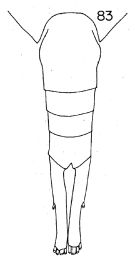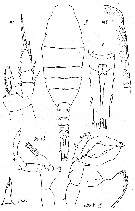|
|
 |
Fiche d'espèce de Copépode |
|
|
Calanoida ( Ordre ) |
|
|
|
Lucicutiidae ( Famille ) |
|
|
|
Lucicutia ( Genre ) |
|
|
| |
Lucicutia intermedia Sars, 1905 (F,M) | |
| | | | | | | Syn.: | Lucicutia philyra A. Scott, 1909 (p.128, figs.F); Sewell, 1948 (p.553); L. tenuicauda : Grice & Hülsemann, 1965 (p.224); ? Lucicutia cf. intermedia Markhaseva & Ferrari, 2005 (p.1098, Rem.) | | | | Ref.: | | | Sars, 1905 c (p.8, Rem.F); 1925 (p.215, figs.F,M); Hülsemann, 1966 (p.721, figs.F,M); Heptner, 1971 (p.131, figs.M); Boxshall & Halsey, 2004 (p.133: F; p.134: M); Vives & Shmeleva, 2007 (p.335, figs.F,M, Rem.) |  Issued from : G.O. Sars in Résult. Camp. Scient. Prince Albert I, 69, pls.1-127 (1924). [Pl.LVIII, figs.4-8]. Female: 4, habitus (dorsal); 5, P1; 6, P5; 7, anal segment and caudal rami (dorsal). Male: 8, P5.
|
 issued from : K. Hülsemann in Bull. Mar. Sc, 1966, 16 (4). [p.720, Fig.83]. Female: 83, urosome (dorsal).
|
 issued from : K. Hülsemann in Bull. Mar. Sc, 1966, 16 (4). [p.726, Fig.113]. Male: 113, P5. R = right leg; L = left leg.
|
 issued from : A. Scott in Siboga-Expedition, 1909, XIX a. [Plate XL, Figs.10-18]. As Lucicutia philyra. Female (from Celebes Sea): 10, habitus (dorsal); 11, forehead (lateral); 12, last thoracic and genital segments (left side); 13, A1; 14, Md (masticatory edge); 15, Mx2; 16, Mxp; 17, P1; 18, P5.
|
 issued from : M.V. Heptner in Trudy. Inst. Okeanol., 1971, 92. [p.131, Fig.28]. Male (from Kuril-Kamchatka Trench). pbs I, spine-like on outer margin of basipod of P1; pbs V, inner distal margin of basis of left P5 with row of spinous processes around inner distal angle.
|
 Lucicutia intermedia Lucicutia intermedia female: 1 - Characters following not combined : Prosome about 3 times longer than urosome. Cephalosome with slightly projecting and rounded anterior corners and well developed lateral spinous projections; anal somite about as long as wide; caudal rami 11.7 times longer than wide and bowed outwards at base, leaving elliptical space between rami proximally. 2 - P1 with 3-segmented endopod. 3 - Cephalosome without spinous projections. 4 - Genital double-somite symmetrical (dorsal view). 5 - Anal somite much shorter than caudal ramus. 6 - P5 with 3-segmented endopod. 7 - Characters not combined between distal 3 to 4 segments of A1 reaching beyond tip of caudal ramus and body length less than 3mm. 8 - Cephalosome without projections. 9 - Terminal setal element of P5 about equal to length of 3rd exopodal segment; body length over 2 mm. 10 - Caudal rami about 7 times longer than wide. Genital double-somite just wider than long.
|
 Lucicutia intermedia Lucicutia intermedia male: 1 - P1 with 3-segmented endopod. 2 - Cephalosome without lateral projections. 3 - Right A1 reaching at most 2 segments beyond tip of caudal rami. 4 - Caudal rami at most 7 times longer than wide. 5 - Inner margin of basis of both P5 without pointed process; endopod of right P5 -2 segmented. . 6 - Caudal rami more than 4 times longer than wide. 7 - Body length more than 2.0 mm. 8 - Basis of left P5 with produced inner distal corner with 3 teeth.
| | | | | Ref. compl.: | | | Lysholm & al., 1945 (p.35); Sewell, 1948 (p.503); Grice & Hulsemann, 1965 (p.224); 1967 (p.17); Park, 1970 (p.477); Deevey & Brooks, 1977 (p.256, tab.2, Station "S"); Lapernat, 2000 (tabl.3, 4) | | | | NZ: | 6 | | |
|
Carte de distribution de Lucicutia intermedia par zones géographiques
|
| | | | | | | | | | Loc: | | | off NW Cape Verde Is., Canary Is., Madeira, Portugal, E Azores, Bay of Biscay, Caribbean Sea, off Bermuda (Station "S"), Sargasso Sea, W Medit. (off Monaco), Indian, Indonesia-Malaysia (Celebes Sea), ? Kuril-Kamchatka Trench | | | | N: | 11 | | | | Lg.: | | | (1) F: 3,6; (5) F: 3,4; (21) F: 4,1-3,4; M: 3,5 ; (23) M: 4; {F: 3,40-4,10; M: 3,50-4,00}
| | | | Rem.: | Sars (1925) signale cette espèce à la station 1991 au sud de Monaco, mais ne la mentionne pas dans le texte comme en Méditerranée (p.216).
Voir aussi les remarques en anglais | | | Dernière mise à jour : 16/01/2015 | |
|
|
 Toute utilisation de ce site pour une publication sera mentionnée avec la référence suivante : Toute utilisation de ce site pour une publication sera mentionnée avec la référence suivante :
Razouls C., Desreumaux N., Kouwenberg J. et de Bovée F., 2005-2026. - Biodiversité des Copépodes planctoniques marins (morphologie, répartition géographique et données biologiques). Sorbonne Université, CNRS. Disponible sur http://copepodes.obs-banyuls.fr [Accédé le 12 janvier 2026] © copyright 2005-2026 Sorbonne Université, CNRS
|
|
 |
 |








